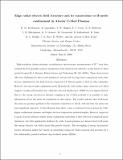Edge radial electric field structure and its connections to H-mode confinement in Alcator C-Mod Plasmas
Author(s)
Lipschultz, Bruce; McDermott, R. M.; Catto, Peter J.; Granetz, Robert S.; Greenwald, Martin J.; Labombard, Brian; Marr, K.; Rice, John E.; Alcator C-Mod Team; Reinke, Matthew Logan; Hutchinson, Ian Horner; Hughes Jr, Jerry; Hubbard, Amanda E; Whyte, Dennis G; ... Show more Show less
DownloadMcDermott_PoP_May09.pdf (8.067Mb)
PUBLISHER_POLICY
Publisher Policy
Article is made available in accordance with the publisher's policy and may be subject to US copyright law. Please refer to the publisher's site for terms of use.
Terms of use
Metadata
Show full item recordAbstract
High-resolution charge-exchange recombination spectroscopic measurements of B[superscript 5+] ions have enabled the first spatially resolved calculations of the radial electric field (E[subscript r]) in the Alcator C-Mod pedestal region [ E. S. Marmar, Fusion Sci. Technol. 51, 261 (2006) ]. These observations offer new challenges for theory and simulation and provide for important comparisons with other devices. Qualitatively, the field structure observed on C-Mod is similar to that on other tokamaks. However, the narrow high-confinement mode (H-mode) E[subscript r] well widths (5 mm) observed on C-Mod suggest a scaling with machine size, while the observed depths (up to 300 kV/m) are unprecedented. Due to the strong ion-electron thermal coupling in the C-Mod pedestal, it is possible to infer information about the main ion population in this region. The results indicate that in H-mode the main ion pressure gradient is the dominant contributor to the Er well and that the main ions have significant edge flow. C-Mod H-mode data show a clear correlation between deeper E[subscript r] wells, higher confinement plasmas, and higher electron temperature pedestal heights. However, improved L-mode (I-mode) plasmas exhibit energy confinement equivalent to that observed in similar H-mode discharges, but with significantly shallower E[subscript r] wells. I-mode plasmas are characterized by H-mode-like energy barriers, but with L-mode-like particle barriers. The decoupling of energy and particle barrier formation makes the I-mode an interesting regime for fusion research and provides for a low collisionality pedestal without edge localized modes.
Date issued
2009-03Department
Massachusetts Institute of Technology. Department of Nuclear Science and Engineering; Massachusetts Institute of Technology. Plasma Science and Fusion CenterJournal
Physics of Plasmas
Publisher
American Institute of Physics
Citation
McDermott, R. M. et al. “Edge radial electric field structure and its connections to H-mode confinement in Alcator C-Mod plasmas.” Physics of Plasmas 16.5 (2009): 056103-12. ©2009 American Institute of Physics.
Version: Author's final manuscript
ISSN
1070-664X
1089-7674